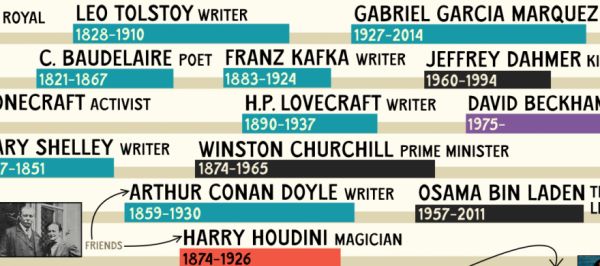A wise man never knows all, only fool knows everything …
Kicking the evening of Crusty pizzas with Gagan and Glen Fiddich
Botanists identify 33 global ‘dark spots’ with thousands of unknown plants Guardian
The Strange Story of the Algorithm Meant to Solve Life, the Universe and Everything Scientific American
Google Wins Lawsuit Against Scammers Who ‘Weaponized’ DMCA Takedowns Torrentfreak
MICROBIOME NEWS: Gut Bacteria Form Communities To Outsmart Medications, New Study Finds

At the subreddit /r/DataIsBeautiful, /u/profound_whatever showcases a huge chart illustrating when famous people in Western Civilization lived. It's useful for showing which lives overlapped each other.
The chart starts at the year 1200 and stretches to the current year. I focused on the era of Winston Churchill, that giant of the Twentieth Century who, during a 90-year lifespan, straddled multiple major political and technological changes.
Some redditors are looking at the simulanteous and sequential lifespans and drawing conclusions:

It would be interesting to see an expanded version that includes Asia. But other redditors are complaining about particular individuals being left out. I agree: the absence of Gallagher is unsettling.
We know that the world's first computer program was written by Ada Lovelace in 1848. It would have run a theoretical computer called the Analytical Engine designed by Charles Babbage, but he never actually built the computer. However, computer programs are made up of data, flow charts, and calculations. People understood those things, at least some smart people did, long before the algorithms they produced were usable.
For example, if you had enough data, you could forecast the weather. British mathematician Lewis Fry Richardson compiled the necessary data in 1913 and worked out how to calculate the weather of the future. The problem was that the calculations took so long that the "forecast" had passed before it was predicted. If he had a computer, it would have worked much better.
Various people worked out the same types of algorithms for playing chess, tabulating the census, and generating random numbers. They worked, but not well, because human calculation just isn't fast enough. Read about the algorithms that predated the computers that would make them work at Cracked.
Ross Anderson and I share a favorite web page, Wikipedia’s Timeline of the Far Future, which he wrote about for the Atlantic: For How Much Longer Can Life Continue on This Troubled Planet?
Like the best sci-fi world building, the Timeline of the Far Future can give you a key bump of the sublime. It reminds you that even the sturdiest-seeming features of our world are ephemeral, that in 1,100 years, Earth’s axis will point to a new North Star. In 250,000 years, an undersea volcano will pop up in the Pacific, adding an extra island to Hawaii. In the 1 million years that the Great Pyramid will take to erode, the sun will travel only about 1/200th of its orbit around the Milky Way, but in doing so, it will move into a new field of stars. Our current constellations will go all wobbly in the sky and then vanish.
Some aspects of the timeline are more certain than others. We know that most animals will look different 10 million years from now. We know that the continents will slowly drift together to form a new Pangaea. Africa will slam into Eurasia, sealing off the Mediterranean basin and raising a new Himalaya-like range across France, Italy, and Spain. In 400 million years, Saturn will have lost its rings. Earth will have replenished its fossil fuels. Our planet will also likely have sustained at least one mass-extinction-triggering impact, unless its inhabitants have learned to divert asteroids.
I wrote about the timeline back in 2012 (and again in 2017 & 2019).
The timeline of the far future article is far from the longest page on Wikipedia, but it might take you several hours to get through because it contains so many enticing detours. What’s Pangaea Ultima? Oooh, Roche limit! The Degenerate Era, Poincar’e recurrence time, the Big Rip scenario, the cosmic light horizon, the list goes on and on.

